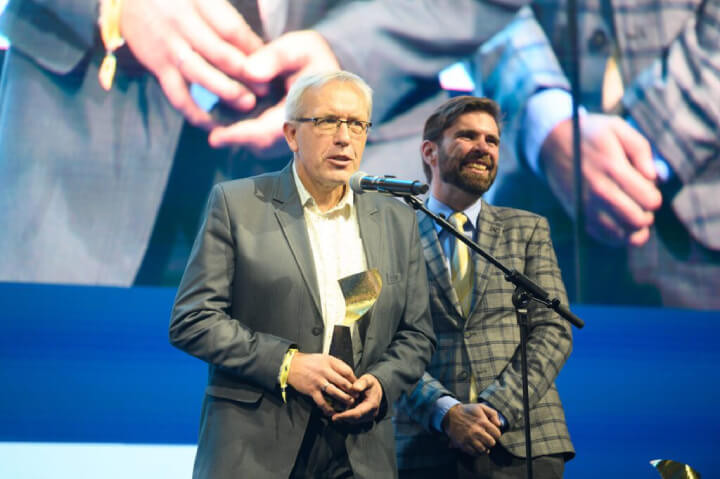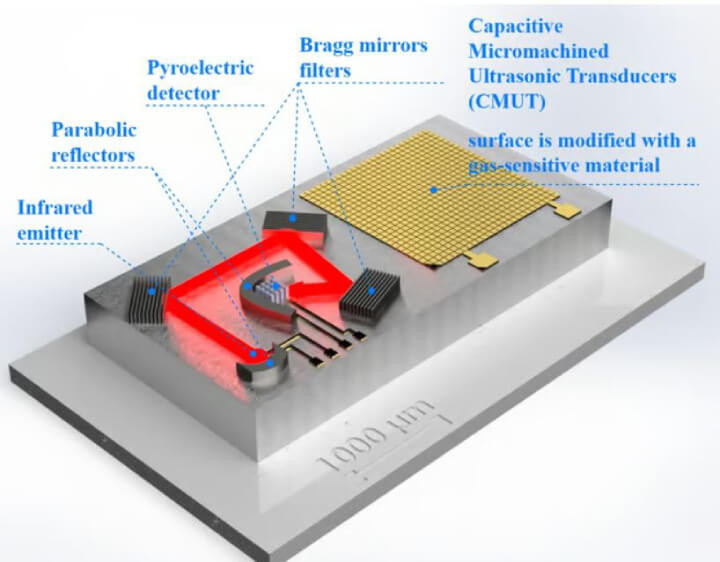Researchers Create Cost-Reducing Greenhouse Gas Detection Sensor
Insights | 01-03-2024 | By Robin Mitchell

Photo of KTU Professor Darius Viržonis by Vygintas Skaraitis.
Key things to know:
- Innovative gravimetric sensors developed by Lithuanian scientists at Kaunas University of Technology offer a cost-effective solution for detecting greenhouse gases.
- Utilising ultrasonic transducers, these sensors can detect trace amounts of gases like CO2, methane, and water vapour with high sensitivity and low energy consumption.
- The technology presents a significant advancement over traditional methods, potentially revolutionising environmental monitoring and safety protocols in various industries.
- Commercialisation efforts by the startup company Orius aim to make this sensor technology widely available, contributing to global efforts in combating climate change and enhancing public safety.
As the need for greenhouse gas sensors increases, utilising common sensing methods can add significant costs to any engineering project, creating a need for cheap sensors. Recognising such challenges, a team of researchers recently published their findings on a newly developed gravimetric-based setup that could see the cost of greenhouse gas sensors significantly lowered. What challenges do typical sensors introduce, what did the researchers demonstrate, and how could such sensors dominate the industry?
What challenges do typical sensors introduce?
With the average global temperature steadily rising, many around the world are concerned that the actions of their respective governments do not go far enough in the fight against climate change. Even those who would normally show little interest in fighting against climate change can understand the need to limit pollution in the environment, reduce environmental destruction, and phase out fossil fuels whose reserves are finite.
While recording environmental data from space can certainly help show global surface temperatures, the best data comes from sensors placed at the source of greenhouse gasses, whether it is chimney stacks, industrial zones, or construction sites. Being able to record this data at the source means that researchers can better understand how greenhouse gasses are generated, which activities produce the most, and identify key areas that, if faced with regulation, could have the biggest impact on the fight against climate change.
However, deploying such sensors would require the manufacture of millions of devices worldwide, and even though this is more than plausible for basic data such as temperature and humidity, trying to record gases such as CO2 introduces numerous challenges.
By far, the biggest challenge in recording greenhouse gasses is that many of them are mostly benign and unreactive (with the two largest being CO2 and water vapour). As typical gas sensors rely on the gas being reactive to some degree (such as in volatile gas sensors that oxidise molecules), trying to detect inert gasses and molecules can be extremely difficult.
One solution is to utilise more complex methods involving spectroscopy, which takes a light source, passes it through a medium, and then measures the absorption lines. While this provides extremely accurate results, such sensors are also massively expensive and not something that can readily be integrated into small IoT sensors scattered across vast environments.
Thus, when it comes to the detection of greenhouse gasses, researchers have to rely on large, expensive sensors that can rarely be deployed with ease.
Researchers demonstrate greenhouse detection using ultrasonic oscillators
Recognising the challenges faced by typical sensors, a team of researchers from Lithuania’s Kaunas University of Technology have recently demonstrated a newly developed sensor that is not only able to detect numerous greenhouse gasses but can do so at a fraction of the price.
This significant reduction in cost without compromising on sensitivity or efficiency is made possible through the innovative use of gravimetric sensors developed by the team at Kaunas University of Technology. Led by Darius Viržonis, this breakthrough technology utilises ultrasonic transducers, offering a more accessible solution for widespread environmental monitoring and contributing to global efforts in combating climate change.
To achieve this feat of engineering, the researchers turned to ultrasonic transducers (specifically, capacitive micromachines ultrasonic transducers, or CMUT) as the active sensing element, exploiting the gravimetric properties of the transducer. Firstly, the ultrasonic transducer is made to have a resonant frequency in the megahertz, which translates to extremely fast and small movements. Secondly, the transducer is coated in gas-sensitive compounds that more readily bind with greenhouse gasses, such as CO2, methane, and water vapour.

The startup company ORIUS will commercialize the invention created by the researchers at KTU.
Due to the extremely high vibration frequency, any change in the mass of the transducers results in a significant change in resonant frequency, meaning that the sensor is extremely sensitive to small changes in mass. Thus, when excess greenhouse gas molecules bond to the transducer surface, the resulting change in frequency indicates not only the presence of that gas but also its concentration.
The principle behind these gravimetric sensors involves changes in the oscillation frequency of the sensing elements, which directly correlate with mass changes due to the binding of greenhouse gas molecules. This innovative approach not only highlights the sensor's acute sensitivity but also its potential for broader applications in detecting various environmental pollutants and even virus DNA, as noted by the research team.
According to the researchers, the sensor technology is already being commercialised, and initial results have shown that the developed sensor is far more cost-effective compared to other solutions. Furthermore, the use of MEMS technology means that the sensor can easily be integrated into small IoT designs without the need for large power sources or dedicated workstations to utilise the hardware.
Could such sensors dominate the industry?
The use of gravimetric sensors for detecting trace amounts of greenhouse gases is undoubtedly a stroke of genius on the part of the researchers, but while it will certainly help the field of greenhouse gas detection, it could very well open up new opportunities in other areas.
One potential application for such sensors could be in explosive environments. Depending on the sensing technology, some volatile organic compound sensors utilise an oxidiser to detect explosive gases, and while these do work, they also carry an inherent risk of accidental ignition (as a result of using a small heater). But if an ultrasonic transducer is used, due to the significantly lower voltage and current requirements (along with the ability to not oxidise the gas), it is possible for far safer sensors to be developed.
Beyond environmental monitoring, the gravimetric sensor technology developed by Lithuanian scientists holds promise for enhancing safety in potentially explosive environments. Its low voltage and current requirements, combined with the absence of a need to oxidize the gas, present a safer alternative to traditional volatile organic compound sensors, potentially revolutionising safety protocols in various industries.
Considering that the sensor is already in the stages of commercialisation, it won’t be long before we see these devices become available to engineers. From there, we will likely see numerous climate-change IoT devices being released that can be deployed en-masse, allowing for researchers to rapidly obtain data and get a better understanding of not only how to reduce the effects of climate change but readily identify sources of emissions.
The commercialisation efforts by the startup company Orius, stemming from the research conducted at Kaunas University of Technology, signify a crucial step towards making this advanced sensor technology widely available. The potential for its adoption across various sectors could dramatically enhance our ability to monitor and mitigate the impact of greenhouse gases, marking a significant advancement in environmental conservation efforts.

